Welcome to the True Refrigerator Troubleshooting Manual‚ your comprehensive guide to resolving common issues and maintaining optimal performance. This manual is designed to help users diagnose and fix problems efficiently‚ ensuring your refrigerator operates at its best. With detailed steps and expert advice‚ it empowers you to address challenges confidently‚ saving time and reducing the need for professional assistance. Regular maintenance and troubleshooting tips are included to extend the lifespan of your appliance and prevent future issues. Refer to this manual for clear‚ step-by-step solutions tailored to your True refrigerator model.
1.1 Overview of the Manual’s Purpose and Structure
This manual is designed to guide users through troubleshooting and maintaining their True refrigerator effectively. It outlines common issues‚ diagnostic techniques‚ and solutions to ensure optimal performance. Organized into clear sections‚ the manual covers temperature-related problems‚ noise issues‚ water leaks‚ and error codes. Each chapter provides step-by-step instructions‚ helping users identify and resolve problems efficiently. The structure ensures easy navigation‚ making it a valuable resource for both beginners and experienced users.
1.2 Importance of Regular Maintenance and Troubleshooting
Regular maintenance and troubleshooting are crucial for ensuring your True refrigerator operates efficiently and reliably. By addressing issues early‚ you can prevent breakdowns‚ reduce repair costs‚ and extend the appliance’s lifespan. This manual provides guidance on identifying and resolving common problems‚ helping you maintain optimal performance and avoid costly damages. Consistent upkeep ensures your refrigerator runs smoothly‚ preserving your food and reducing energy consumption.
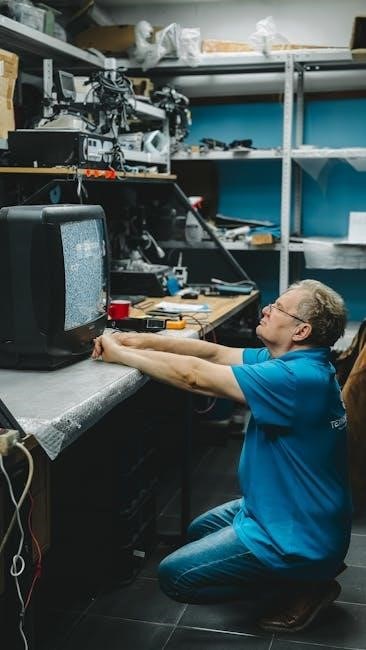
Common Issues in True Refrigerators
True refrigerators may experience temperature fluctuations‚ excessive noise‚ water leaks‚ or error codes. These issues often stem from improper maintenance or component wear‚ requiring timely attention.
2.1 Temperature Fluctuations and Inconsistent Cooling
Temperature fluctuations and inconsistent cooling are common issues in True refrigerators. These problems can arise from faulty thermostats‚ blocked air vents‚ or a malfunctioning compressor. Ensure the thermostat is set correctly and check for obstructions in vents. If issues persist‚ inspect the condenser coils for dust buildup‚ as this can impede cooling efficiency. Addressing these factors can restore stable temperature control and optimal performance.
2.2 Excessive Noise or Unusual Sounds
Excessive noise or unusual sounds from your True refrigerator can indicate issues with internal components. Common causes include loose parts‚ worn-out fan motors‚ or a malfunctioning compressor. Inspect the evaporator and condenser fans for obstructions or damage. Ensure the refrigerator is properly leveled‚ as imbalance can amplify noise. If the issue persists‚ check for worn-out bearings or compressors and consider replacing them to restore quiet operation.

2.3 Water Leaks or Ice Buildup
Water leaks or excessive ice buildup in your True refrigerator can stem from clogged drain systems‚ faulty water supply lines‚ or improper defrost settings. Regularly inspect the drain for blockages and ensure water lines are secure. Check the defrost timer and settings to prevent over-icing. Addressing these issues promptly can prevent damage and maintain efficient operation. Always refer to the manual for specific guidance on diagnosing and resolving these problems effectively.
2.4 Error Codes and Their Meanings
True refrigerators display error codes to indicate specific issues‚ such as temperature fluctuations or sensor malfunctions. These codes‚ like “E1” or “E2‚” provide clues for diagnosing problems. The manual includes a detailed list of codes‚ their meanings‚ and corresponding solutions. Understanding these codes enables users to address issues promptly‚ preventing further complications. Always reference the manual for accurate interpretations and step-by-step fixes to ensure optimal appliance performance and longevity.
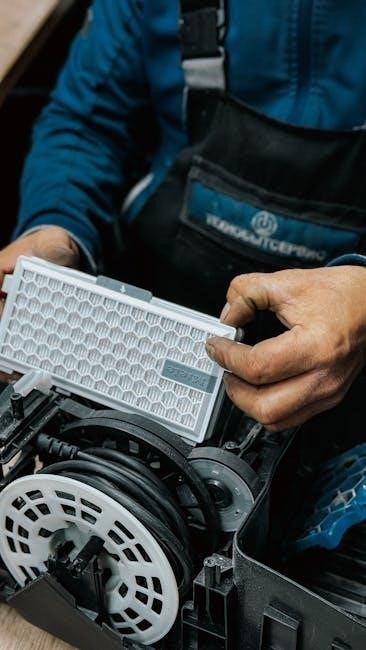
Diagnostic Tools and Techniques
Utilize diagnostic tools like multimeters‚ thermometers‚ and error code lists to identify issues. Techniques include visual inspections‚ basic tests‚ and advanced troubleshooting methods for accurate problem identification and resolution.
3.1 Using the True Refrigerator Error Code List
The True Refrigerator Error Code List is a vital diagnostic tool‚ helping users identify specific issues quickly. Each error code corresponds to a particular problem‚ providing clear solutions or maintenance steps. Referencing this list ensures accurate troubleshooting‚ reducing downtime and potential damage. Access the list online or in your manual to streamline repairs and maintain your appliance’s performance effectively.
3.2 Understanding the Control Panel and Display
The control panel and display are essential for monitoring your True refrigerator’s status. They provide real-time information on temperature settings‚ error codes‚ and operational modes. Familiarize yourself with the interface to adjust settings‚ view diagnostics‚ and address alerts. Error codes like E1‚ E2‚ or E3 indicate specific issues‚ guiding you to solutions. Use the display to navigate menus‚ check error logs‚ and reset the appliance when needed for optimal performance.
3.3 Basic Diagnostic Tests for Common Problems
Start by checking error codes on the display‚ which indicate specific issues like temperature malfunctions or sensor problems. Perform a power reset by unplugging the refrigerator for 30 seconds. Inspect the door seals for proper closure and ensure vents are unobstructed. Test the thermostat by adjusting settings and monitoring changes. Verify fan operation and check for blockages in the condenser coils. Refer to the manual for detailed diagnostic procedures tailored to your model.
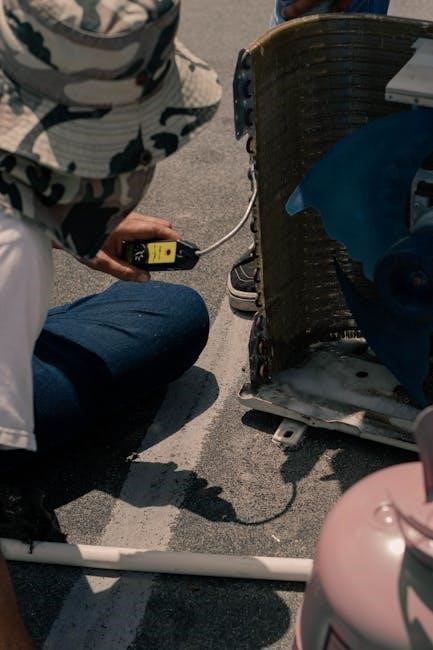
Troubleshooting Temperature-Related Problems
Address temperature issues by checking the thermostat‚ ensuring proper door seals‚ and verifying airflow. Adjust settings and inspect sensors for accurate cooling performance and consistency.

4.1 Checking the Thermostat and Temperature Settings
Start by accessing the control panel to verify the set temperature. Ensure the thermostat is set correctly and not affected by external factors. Check for any blockages near the temperature sensors. If issues persist‚ consult the manual for recalibration steps. Avoid extreme temperature settings‚ as they may cause inconsistent cooling. Regularly review and adjust settings to maintain optimal performance and energy efficiency.
4.2 Inspecting the Door Seals for Proper Closure
Ensure the door seals are free from wear‚ tears‚ or dirt‚ as this can compromise the refrigerator’s cooling efficiency. Check the alignment of the doors to confirm they close evenly and tightly. Clean the seals with mild soap and water to maintain their integrity. Test the seal by placing a dollar bill between the door and frame; it should hold firm. Replace damaged seals promptly to prevent temperature fluctuations and maintain optimal performance.
4.3 Ensuring Proper Airflow and Ventilation
Proper airflow is crucial for maintaining consistent temperatures and humidity levels in your True refrigerator. Ensure the unit has adequate space around it for air to circulate freely. Check for blockages in vents or grilles and clean them regularly. Avoid overcrowding shelves‚ as this can restrict airflow. Regularly inspect and clean the condenser coils to prevent dust buildup‚ which can impede ventilation and reduce efficiency. Proper ventilation ensures optimal performance and extends the appliance’s lifespan.
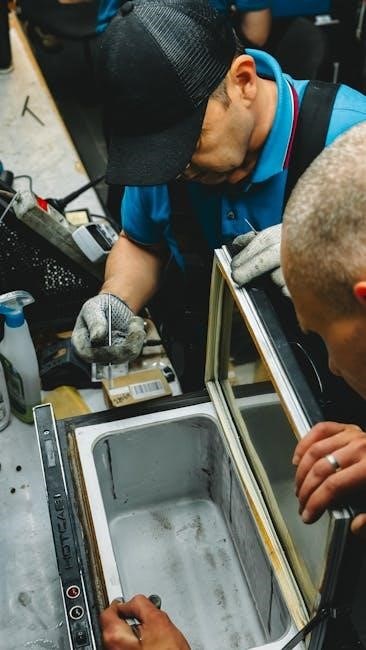
Addressing Noise and Vibration Issues
Noise and vibrations in your True refrigerator can often be resolved by ensuring proper leveling‚ checking for worn parts‚ and maintaining balanced operation for smooth performance.
5.1 Identifying the Source of the Noise
To address noise issues‚ start by identifying the source. Common culprits include the compressor‚ fan motors‚ or evaporator. Check for obstructions blocking airflow or loose parts causing vibrations. Ensure the refrigerator is level‚ as imbalance can amplify noise. Listen carefully to determine if the sound originates from the rear‚ bottom‚ or interior components. This step is crucial for targeted repairs and minimizing disruption.
5.2 Leveling the Refrigerator for Stability
Proper leveling is essential to prevent vibrations and noise. Ensure the refrigerator is evenly balanced on all four feet. Use a level tool to check alignment and adjust the feet as needed. This step minimizes operational noise and ensures doors seal correctly. Regularly verify the balance to maintain stability and optimal performance‚ especially after moving the appliance or during maintenance checks.
5;3 Replacing Worn-Out Parts or Compressors
Identify worn-out parts such as compressors‚ fans‚ or seals‚ which may cause noise or performance issues. Replace them with genuine True refrigerator parts to ensure compatibility and efficiency. For compressors‚ shut off power and follow safety guidelines. Consult the manual or a professional for complex replacements. Regular inspections can prevent sudden failures‚ ensuring your refrigerator runs smoothly and maintains optimal cooling performance over time.
Solving Water Leak and Ice Buildup Problems
Address water leaks by inspecting supply lines and connections. For ice buildup‚ check the drain system and adjust defrost settings. Regular maintenance prevents future issues.
6.1 Checking the Water Supply Lines and Connections
Inspect water supply lines for leaks‚ kinks‚ or blockages. Ensure all connections are secure and not loose. Turn off the water supply before examining lines. Check for mineral buildup or corrosion‚ which can restrict water flow. Replace any damaged or worn-out lines to prevent leaks. Securely tighten all connections to avoid water seepage. Regular inspections help maintain proper function and prevent future issues.
6.2 Inspecting the Drain System for Blockages

Locate the drain system‚ typically found at the bottom or back of the refrigerator. Check for blockages like ice buildup or debris. Use a flashlight to inspect hidden areas. If clogged‚ unplug the appliance and carefully remove blockages with a soft brush or warm water. Ensure the drain pan is clean and properly positioned. Regular cleaning prevents water accumulation and potential leaks. Addressing drain issues promptly maintains efficient operation.
6.3 Adjusting the Defrost Settings and Timers
Access the defrost settings via the control panel or manual. Adjust the timer to ensure proper defrost cycles‚ preventing excessive ice buildup. Check the defrost sensor for accuracy and clean it if necessary. Ensure the defrost drain is clear to avoid water accumulation. Regularly reviewing and adjusting these settings helps maintain efficient cooling and prevents system strain. Consult the manual for specific instructions tailored to your model.
Understanding and Clearing Error Codes
Error codes indicate specific issues. Refer to the error code list for meanings. Clear codes by resetting the refrigerator or updating the control panel software.
7.1 Common Error Codes and Their Solutions
Common error codes like E1‚ E2‚ and E3 indicate sensor malfunctions or communication issues. E1 often relates to temperature sensor problems‚ while E2 may signal a faulty door switch. E3 could indicate a malfunctioning compressor or fan. Solutions include checking sensor connections‚ ensuring proper airflow‚ and resetting the refrigerator. For persistent issues‚ consult the manual or contact a certified technician for professional assistance.
7.2 Resetting the Refrigerator After an Error
Resetting your True refrigerator after an error involves disconnecting power for 30 seconds to reset the control system. Unplug the unit‚ wait‚ then reconnect to restore default settings. This step often clears minor glitches and error codes. Ensure the refrigerator is empty of perishables before resetting. If issues persist‚ consult the manual or contact a technician for further assistance. Regular resets can prevent recurring errors.
7.3 Updating the Control Panel Software
Updating the control panel software ensures optimal performance and resolves error codes. Check for updates on the True Refrigerator website‚ download the latest version‚ and follow the manual’s installation guide. Power off the unit before updating to prevent interruptions. After installation‚ restart the refrigerator to apply changes. Regular software updates enhance functionality and fix bugs‚ ensuring your appliance operates efficiently and reliably.
Maintenance Tips to Prevent Future Issues
Regularly clean condenser coils‚ inspect door seals‚ and check drainage systems to prevent issues. Schedule professional maintenance annually and monitor performance to ensure optimal operation and longevity.
8.1 Cleaning the Condenser Coils Regularly
Cleaning the condenser coils is essential for maintaining your True refrigerator’s efficiency. Turn off power‚ then gently vacuum or brush the coils to remove dust and debris. This ensures proper airflow‚ prevents overheating‚ and maintains optimal cooling performance. Clean the coils every 6 months or as needed‚ especially in dusty environments. Regular cleaning extends the appliance’s lifespan and reduces energy consumption.
8.2 Scheduling Professional Maintenance Visits
Scheduling professional maintenance visits is crucial for ensuring your True refrigerator operates efficiently. A certified technician will inspect and clean components‚ check for wear‚ and perform necessary adjustments. Plan annual visits to prevent issues before they arise. Regular professional checks help maintain optimal performance‚ extend the appliance’s lifespan‚ and ensure reliability. This proactive approach saves time and money by addressing potential problems early.

8.3 Monitoring the Refrigerator’s Performance
Regularly monitoring your True refrigerator’s performance ensures optimal operation and prevents unexpected issues. Check temperature settings‚ door seals‚ and error codes to identify potential problems early. Listen for unusual noises and observe ice or water dispensers for proper function. Keep track of energy consumption and adjust settings as needed. This proactive approach helps maintain efficiency‚ reduces wear‚ and extends the appliance’s lifespan. Always refer to the manual for guidance.
Safety Precautions During Troubleshooting
Always disconnect power before repairs to avoid electric shocks. Handle refrigerants and chemicals with care. Avoid DIY fixes for complex issues to ensure safety and prevent further damage.
9.1 Disconnecting Power Before Repairs
Disconnecting power before repairs is crucial for safety. Switch off the circuit breaker or unplug the refrigerator to prevent electric shocks or injuries. Always verify the power is off using a voltage tester. This step ensures your safety while handling internal components or performing diagnostics. Never attempt repairs while the appliance is energized‚ as it poses serious risks. Prioritize caution to avoid accidents and damage to the refrigerator.
9.2 Handling Refrigerants and Chemicals Safely
When handling refrigerants and chemicals‚ always wear protective gloves and goggles to prevent skin and eye irritation. Ensure proper ventilation to avoid inhaling harmful fumes. Follow manufacturer guidelines for handling and disposal to prevent environmental contamination. Never mix chemicals‚ and keep them away from heat sources. If unsure‚ consult a professional to avoid accidents and ensure compliance with safety standards.
9.3 Avoiding DIY Repairs for Complex Issues
Complex refrigerator repairs‚ such as those involving compressors or sealed systems‚ should not be attempted as DIY projects. These tasks require specialized tools and expertise to ensure safety and effectiveness. Improper handling can lead to further damage‚ safety hazards‚ or environmental risks. Always consult a certified technician for such issues to guarantee proper resolution and prevent potential harm to yourself or the appliance.
When to Call a Professional
Persistent issues‚ complex mechanical problems‚ or safety risks indicate the need for professional intervention. Contact a certified technician to ensure proper and safe repairs.
10.1 Recognizing Symptoms Beyond DIY Fixes
Identify when issues exceed DIY solutions‚ such as persistent temperature fluctuations‚ unusual noises‚ or electrical malfunctions. If problems like compressor failure or gas leaks arise‚ professional expertise is essential. Complex repairs requiring specialized tools or knowledge should always be handled by certified technicians to ensure safety and prevent further damage. Recognizing these signs early can prevent costly repairs and ensure your refrigerator operates safely and efficiently.
10.2 Finding a Certified True Refrigerator Technician
To ensure reliable repairs‚ locate a certified True refrigerator technician through the official True website or authorized service providers. Verify certifications and read customer reviews to confirm expertise. Contact True’s customer support for recommendations. Hiring a certified technician guarantees compliance with manufacturer standards‚ validates warranties‚ and ensures high-quality‚ safe repairs tailored to your appliance’s specific needs.
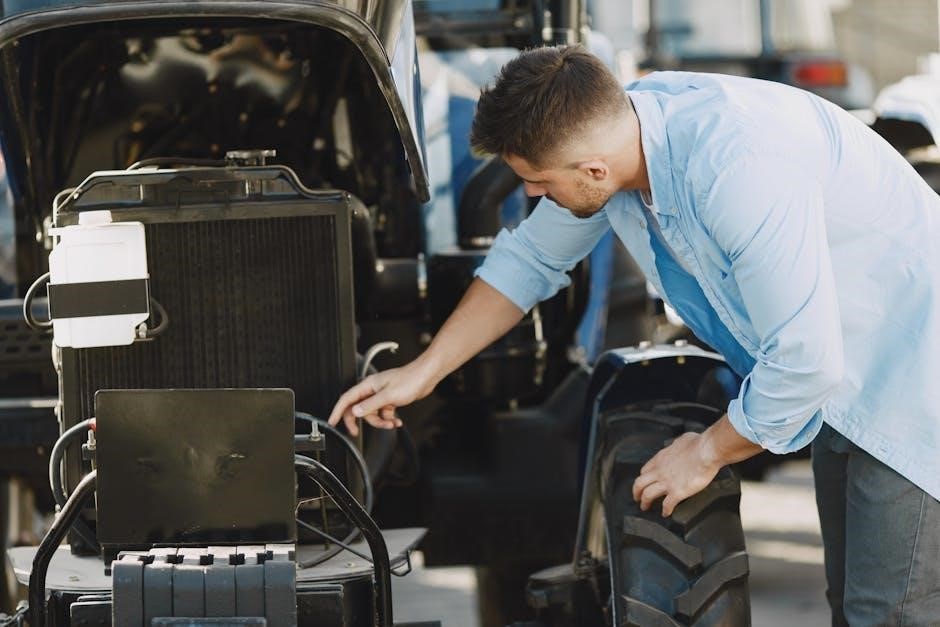
10.3 Understanding Warranty and Service Options
Understanding your True refrigerator’s warranty and service options is crucial for maintaining coverage and ensuring repairs are handled properly. Review the warranty terms to know the duration and scope of coverage for parts and labor. Extended service plans may be available for added protection. Contact True’s customer service to verify warranty status and explore service options tailored to your appliance’s needs.
User Experiences and Feedback
Users share insights on common issues and successful troubleshooting experiences. Many highlight the manual’s clarity in resolving temperature fluctuations and noise problems‚ while others appreciate tips from experienced owners.
11.1 Common User Complaints and Solutions
Users frequently report issues like temperature fluctuations and excessive noise. Solutions often involve checking door seals‚ leveling the fridge‚ and ensuring proper ventilation. Some also mention error codes‚ which can be resolved by referencing the manual or updating software. Experienced users recommend regular condenser cleaning and professional maintenance to prevent recurring problems and extend appliance lifespan.
11.2 Success Stories from Effective Troubleshooting
Many users have successfully resolved issues like temperature fluctuations and ice buildup by following the manual’s guidance. One user fixed inconsistent cooling by adjusting the thermostat settings‚ while another resolved water leaks by inspecting and tightening supply lines. These success stories highlight how the manual empowers users to diagnose and repair issues confidently‚ saving time and money. Experienced users often share tips‚ fostering a supportive community.
11.3 Tips from Experienced Users
Experienced users recommend regular condenser coil cleaning to maintain efficiency and prevent overheating. Checking door seals quarterly and ensuring proper airflow can resolve temperature issues. Many suggest keeping a troubleshooting checklist for quick reference. Some users also advise documenting error codes and solutions for future use. These practical tips‚ shared by seasoned users‚ enhance troubleshooting effectiveness and prolong appliance lifespan.
Thank you for using the True Refrigerator Troubleshooting Manual. By following these guidelines‚ you’ll ensure optimal performance and extend your appliance’s lifespan. Regular maintenance is key to preventing future issues. Refer to this manual whenever you need assistance‚ and enjoy a trouble-free refrigeration experience.
12.1 Summary of Key Troubleshooting Steps
Identify the issue using error codes or symptoms‚ then follow targeted solutions. Check temperature settings‚ door seals‚ and airflow for cooling problems. Inspect water lines and drains for leaks. For noise‚ ensure proper leveling and inspect components. Reset the refrigerator after addressing errors and update software if needed. Regular maintenance‚ like cleaning condenser coils‚ prevents future issues. Always refer to this manual for guidance.
12.2 Encouragement for Regular Maintenance
Regular maintenance is essential for optimal performance and longevity of your True refrigerator. By checking temperature settings‚ cleaning condenser coils‚ and inspecting door seals‚ you can prevent issues before they arise. Schedule professional visits annually and monitor performance consistently. These practices ensure energy efficiency‚ reliability‚ and extended lifespan‚ saving you time and money in the long run.
12.3 Importance of Referencing the Manual
Referencing the True Refrigerator Troubleshooting Manual is crucial for accurate diagnostics and repairs. It provides model-specific guidance‚ ensuring safety and effectiveness. The manual offers precise instructions tailored to your appliance‚ helping you avoid costly mistakes. Regularly consulting it keeps you informed about maintenance and repair best practices‚ making it an indispensable resource for both new and experienced users.
